The Staccato CS is dependable and lightning-fast. Tyler Freel
We may earn revenue from the products available on this page and participate in affiliate programs. Learn More ›
“Guns are like cars. If you want to go fast, it’s gonna cost some money.”
Those words stuck with me as I packed up my gear at the range. They wrapped up a farewell from an older gentleman and his wife after I’d had them both fire a few magazines through the Staccato CS that I was there to test. We’d joked about him having to buy one as his small-statured wife looked anything but frail as she chewed a hole the center A-zone on a USPSA silhouette with the pint-sized 9mm pistol.
The Staccato CS is new for 2023, and it’s the latest in Staccato’s line of 2011 9mm pistols. The CS is smaller than their previous C and C2 compact models, but promises to deliver the level of performance that 2011 pistols like the Staccato P have established. The world of concealed-carry pistols is a buyer’s market, and a premium gun at a premium price is going to have to bring the goods if a company hopes to strike a chord with discerning shooters.
I’ve been shooting a lot of handguns this winter, and am currently poised to tick over 5,000 rounds of 9mm and 10mm since the beginning of January. I’ve got deep roots in the average-joe Glock caste, but the Staccato P had no trouble winning me over, and its influence gave me very high expectations for the Staccato CS. I noted that Staccato’s punchline for the CS is “Pure Staccato, Just Smaller.” We’ll have to see about that, I thought while looking over the compact 2011 for the first time. I had the feeling that I would either be thoroughly impressed, or bitterly disappointed. There wasn’t room for a middle ground.
Staccato CS Specs

Tyler Freel
- Caliber: 9mm
- Capacity: 16+1
- Action: Single-action, hammer-fired
- Barrel: 3.5-inch, bull profile, fluted, stainless steel
- Dimensions: 7.1 inches (L) x 5.6 inches (H) x 1.2 inches (W)(grip)
- Weight: 27 ounces (w/empty 16-round magazine and Holosun EPS Carry optic) (measured)
- Frame: 7075 billet aluminum
- Slide: 4140 billet steel
- Optics: Cut for optic, uses Dawson Precision optic system
- Controls: Right-handed slide stop, mag catch, ambidextrous safety levers
- Finish: Black DLC
- Grip: Polymer grip module, laser-etched stipple texture
- Sights: Dawson Precision fiber-optic front, serrated black square-notch rear
- Trigger: 1911-style single-action, curved aluminum shoe, 3 pounds, 15 ounces (measured)
- MSRP: $2,499
Getting Spun-Up on the Staccato CS
In mainstream-shooter America, Staccato 2011 (formerly known as STI) is steadily gaining name recognition, but they’re still somewhat of an enigma to most. The world of 2011’s and 2011-style pistols can be a bit of a wormhole for the average shooter but, generally speaking, 2011’s are double-stack 1911’s that use a grip module that’s separate from the frame, not grip scales that are attached to each side of a frame like single-stack 1911’s. Pistols like the Springfield 1911 DS Prodigy and Staccato P are good examples, and I go into greater detail on general 2011 info in those reviews.
The Staccato CS is all 2011, but it’s refined in some key ways that help optimize it for concealed carry. Under Staccato, the concealed-carry line started with the C, which was a single-stack pistol. The C2 is a true double-stack 2011 that holds 16+1 rounds but, like its full-size siblings, it’s beefy. The CS looks and feels like the C2 and P in many ways, but its grip is nearly 8 percent slimmer, and the barrel is almost half an inch shorter. For comparison-sake, the Staccato CS is about the same size as a Sig Sauer P365 XMacro—but slightly thicker. It’s slightly more petite than the venerable Glock G19.
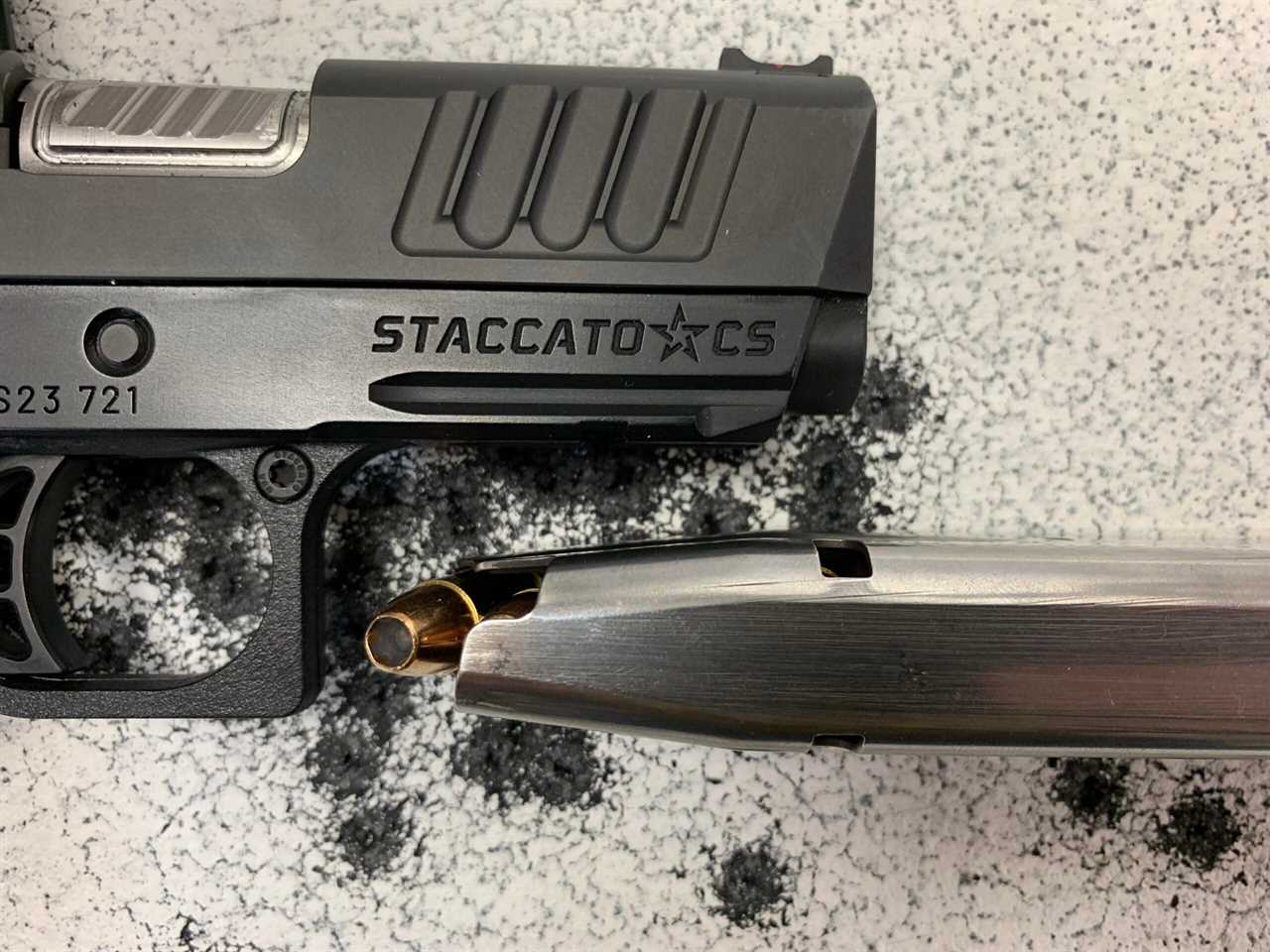
The magazines for the Staccato CS aren’t bottlenecked like normal 2011 mags. Tyler Freel
The Staccato Family Resemblance
There’s no milkman in the Staccato CS’s neighborhood; it looks very much like the other pistols in the family. The CS is a double-stack 1911 with a grip safety, ambidextrous thumb safety, a generous beavertail, skeletonized hammer, and the same lines as Staccato’s full-size pistols. It has a curved aluminum trigger shoe and a wonderfully crisp trigger that breaks at four pounds—give or take an ounce. The trigger has an excellent short reset as well.
The CS has the same front and rear cocking serrations you’ll see on the bigger pistols like the P, XL, and XC; they’re aggressive but not excessive. It has the same scalloping on the bottom side of the slide stop lever too. The frame features a single-slot accessory rail and polymer 2011 grip module with the same sandpaper-like stipple texture that the Staccato P has.
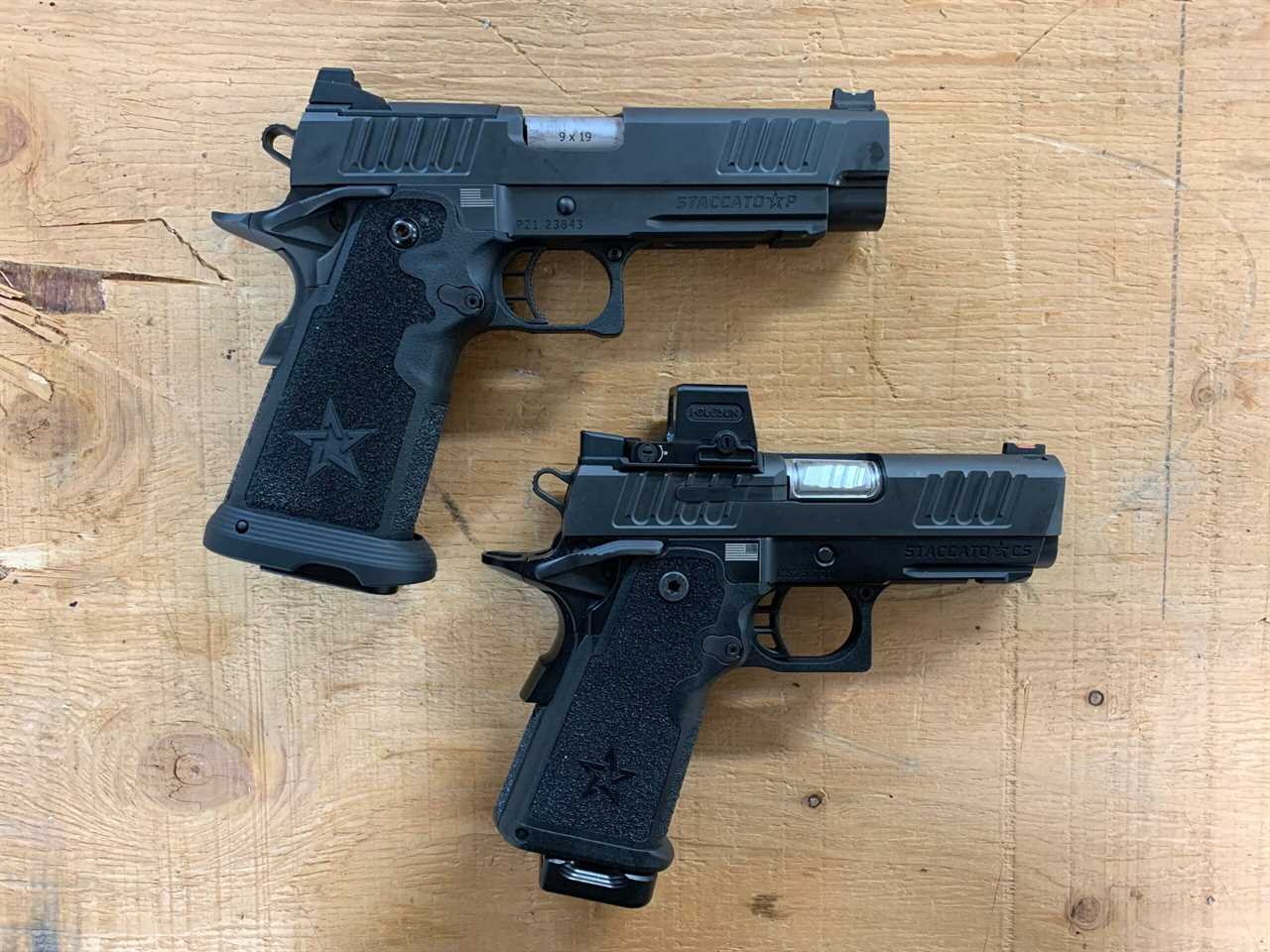
The Staccato CS is very similar to the larger P (top), but is more fitting for concealed carry. Tyler Freel
Unique Features of the Staccato CS
Despite carrying the looks of the larger pistols in the Staccato line, the CS has several key updates that set it apart.
Magazines
The Staccato CS uses 16-round magazines like the C2, but they’re a bit slimmer, shorter, and they lack the notable bottleneck that the typical 2011 magazine has. They are similar in size and shape to the Sig Sauer P365 XMacro magazines, but narrow down more quickly at the top.
The magazines have slick steel bodies, smooth-running followers, and aluminum base plates that are scalloped on either side for gripping them if they don’t fall free of the pistol—loaded or empty, they do generally fall freely when released. The magazines have good spring tension, but are easy to load; full magazines seat easily under a closed slide.
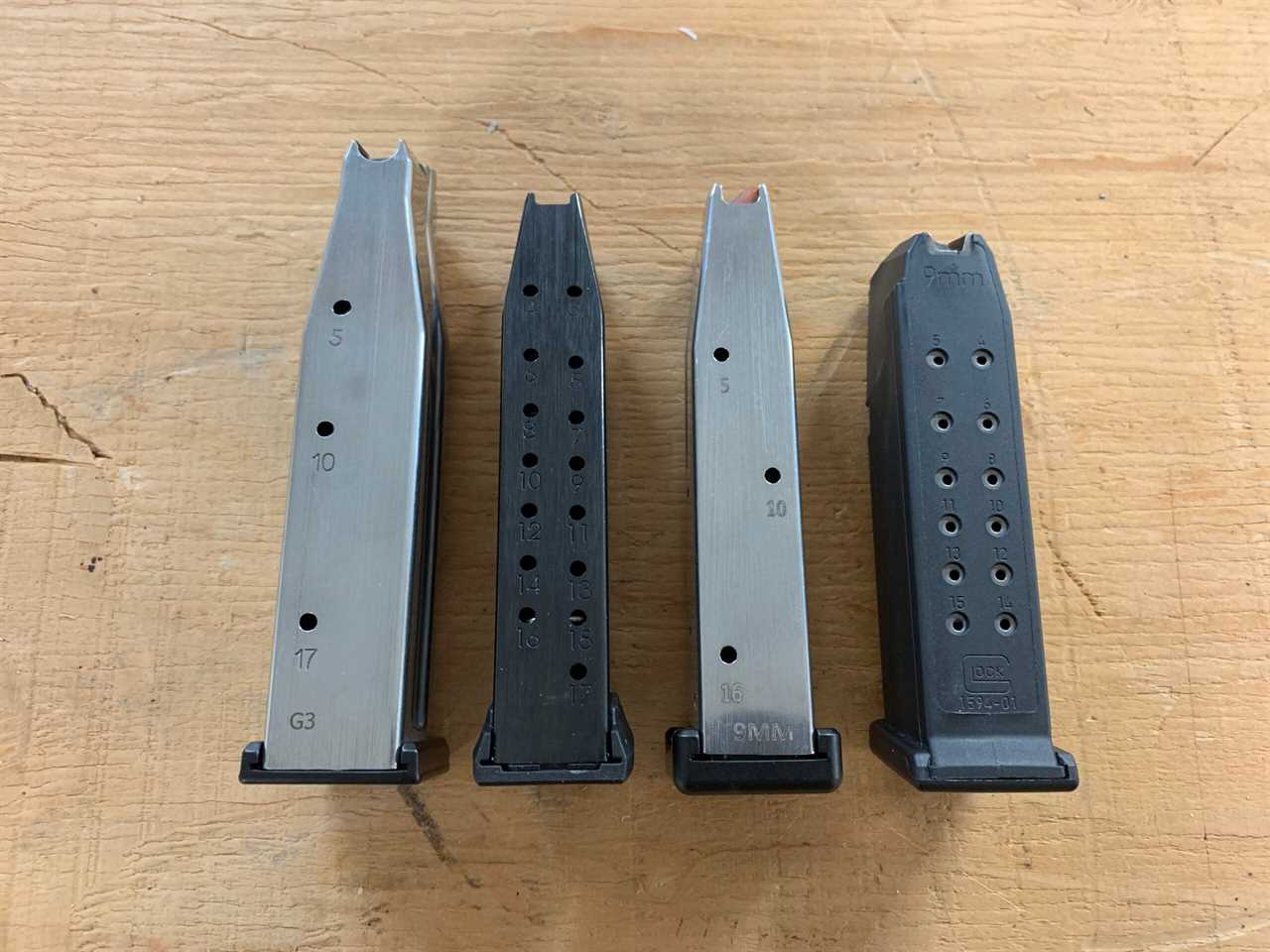
Magazines from left to right: Staccato P 17-round, Sig P365 17-round, Staccato CS 16-round, and Glock G19 15-round. Tyler Freel
Barrel
The Staccato CS has a generally heavy-profile barrel, but with some interesting fluting and machining. The outside of the chamber is machined with a pattern that mimics the slide serrations where it’s exposed in the ejection port, and the concealed portion of the barrel has fluting as well. Other Staccato models have smooth barrels. This machine work isn’t just for looks—it cuts unnecessary weight and helps barrel heat dissipate more quickly. The barrel has the typical 1911/2011 pivoting barrel link at the rear and a gradual recessed crown at the muzzle.
Extractor
Like the other Staccato Pistols, the CS uses a fixed ejector that’s just to the left of the disconnector when facing downrange. However, the extractor is different. Other pistols like the Staccato P use a traditional 1911-style internal extractor. It’s essentially a piece of spring steel that’s installed and removed from the rear of the slide. The springiness of the extractor itself is enough to grab case rims, but the extractor hooks are relatively small. The Staccato CS has a beefy external extractor, with a spring under the back end, that pivots on a pin installed vertically through the slide. The extractor on the CS is similar in size, shape, and function to what you’ll see on the Sig P365. It’s got lots of surface area to grab and hold cases firmly.
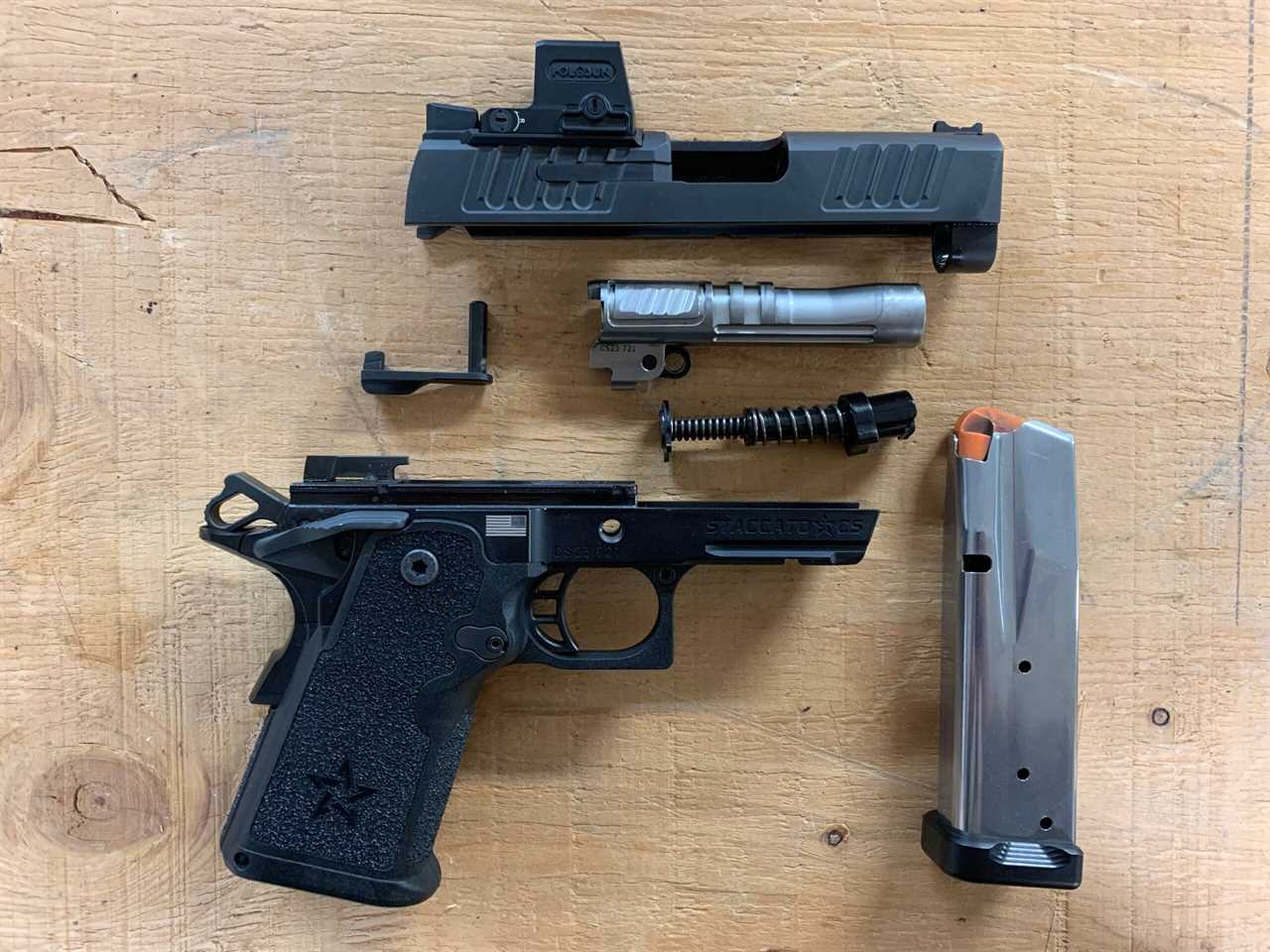
The CS has a dual rod and spring recoil system that softens recoil. Tyler Freel
Recoil System
Although the larger Staccato pistols like the model P use premium full-length guide rods and some modern parts, they’re still 1911-style recoil systems. The Staccato CS has a patent-pending dual spring and rod recoil system made by Dawson Precision. It looks similar to what many striker-fired pistols use, but the front features a spring plug fitting that interfaces with the slide. To remove, simply pull up on the rear of the guide rod and the guide rod system clicks up about 20 degrees—allowing the whole assembly to be pulled free of the slide.
Sights and Optics for the Staccato CS
The bare bones Staccato CS has an optics cut, but comes with a Dawson Precision cover-plate and sights. Like the sights on the P, the CS comes with a variety of fiber-optic colors that you can change out if you like. A variety of pistol red dot plates are available from Staccato or Dawson Precision that come with a small rear sight behind the optic. I ordered my pistol with a plate and Holosun EPS Carry red dot installed, but I’ve also tried the basic iron sight cover plate. I can co-witness my iron sights with the EPS Carry.
Shooting the Staccato CS
I mentioned that I had high hopes for the Staccato CS; I was anxious and a little nervous to shoot it. I’m rooting for every gun I shoot to be a winner, and a lot of them just aren’t. And this pistol was no exception: I really wanted the CS to be everything it’s cracked up to be.
In a few weeks of testing, I fired 1,300 rounds through the Staccato CS (give or take 50 rounds). I’ve fired handloaded and factory ball 9mm ammo of every available weight, and a wide variety of defensive loads too. I have yet to experience a single malfunction of any kind, and shooting the Staccato CS still leaves me in disbelief.
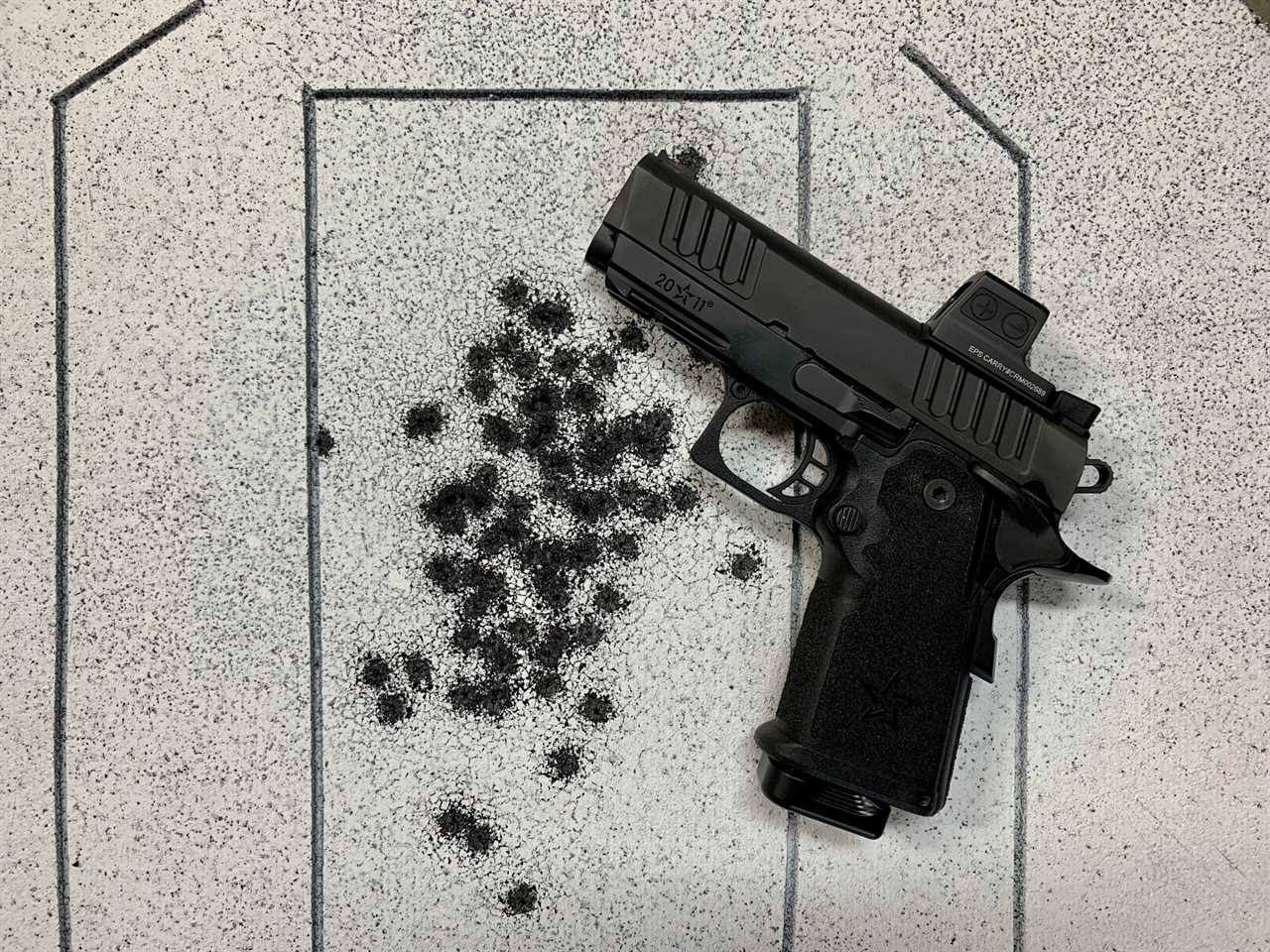
Typical results of a 100-round drill session at 21 feet with the Staccato CS. Tyler Freel
Recoil Control
With the disclaimer that I haven’t shot every single compact concealed-carry pistol on the market, I’ve shot a lot of them—and the Staccato CS is the smoothest-shooting and most accurate compact 9mm I’ve ever fired.
The only thing I can compare it to is its larger sibling, the Staccato P. They are different in some ways: The P has a larger grip that’s easier to index and maintain position, and the recoil cycle of the P feels a little softer because of the heavier, longer slide. However, I can’t say that I can shoot the P much faster than I can shoot the CS with equal accuracy. The CS has a faster recoil cycle that I want to describe as snappy, but it doesn’t snap up with recoil—maybe brisk is a better descriptor. With a good grip, the sights or dot never leave the target during the recoil cycle.
Some striker-fired compact 9mm pistols are very manageable and, when you can develop a good grip, you can do a lot with them. None of them can really compare to the CS though. It’s in a different league.
How Accurate Is the Staccato CS?
The good trigger and smooth-shooting recoil system of the Staccato CS help it achieve excellent accuracy scores for a compact gun. When looking at any pistol—particularly a concealed-carry pistol—I consider primarily practical accuracy: how easy it is to shoot a gun under stress accurately. In the case of high-end guns like the Staccato CS, I’ll also do some on-paper accuracy testing.
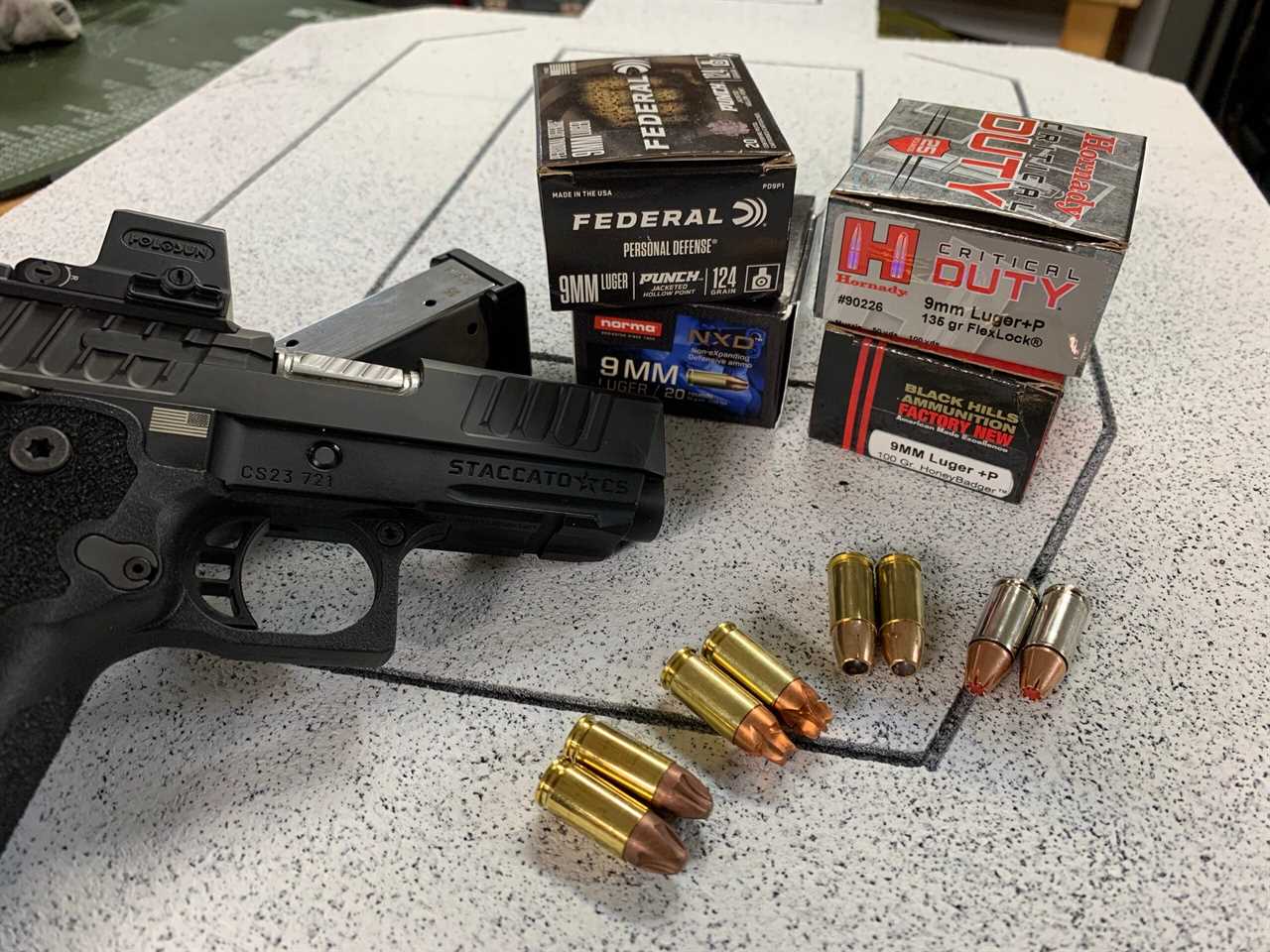
The Staccato CS shoots great with a variety of carry ammo styles and weights. Tyler Freel
I’ll normally gauge the practical accuracy of a compact gun by how easily I can keep most of my hits in the A-zone on a USPSA silhouette at 50 feet while shooting just slow enough to catch the reset. With the Staccato CS, I can burn through entire magazines at about 80- to 90-percent speed, and keep everything in the A-zone. At the shot, the dot wobbles, then drops right back to the center of the target. At 21 feet, I would regularly run through 200 rounds shooting 1-to-5 drills and Bill drills and not drop a single C-zone hit.
To really challenge myself and the pistol, I hung a half-size USPSA silhouette steel plate at 100 yards. I fired several strings of 16 rounds in 20 seconds, and averaged 14 hits per string. That’s something I can’t repeat with most handguns—simply because the triggers won’t allow it. Relatively speaking, most striker-fired triggers feel like trying to break off a birch sapling after becoming accustomed to the CS.
On paper, the CS printed some great groups too. I recorded 10 5-shot groups with three different defensive loads, fired at 50 feet using a sandbag for support. The average group size was .676 inches, and the smallest group was a .357-inch bughole. Compare that to an average of 1.477 inches from my Glock G47.
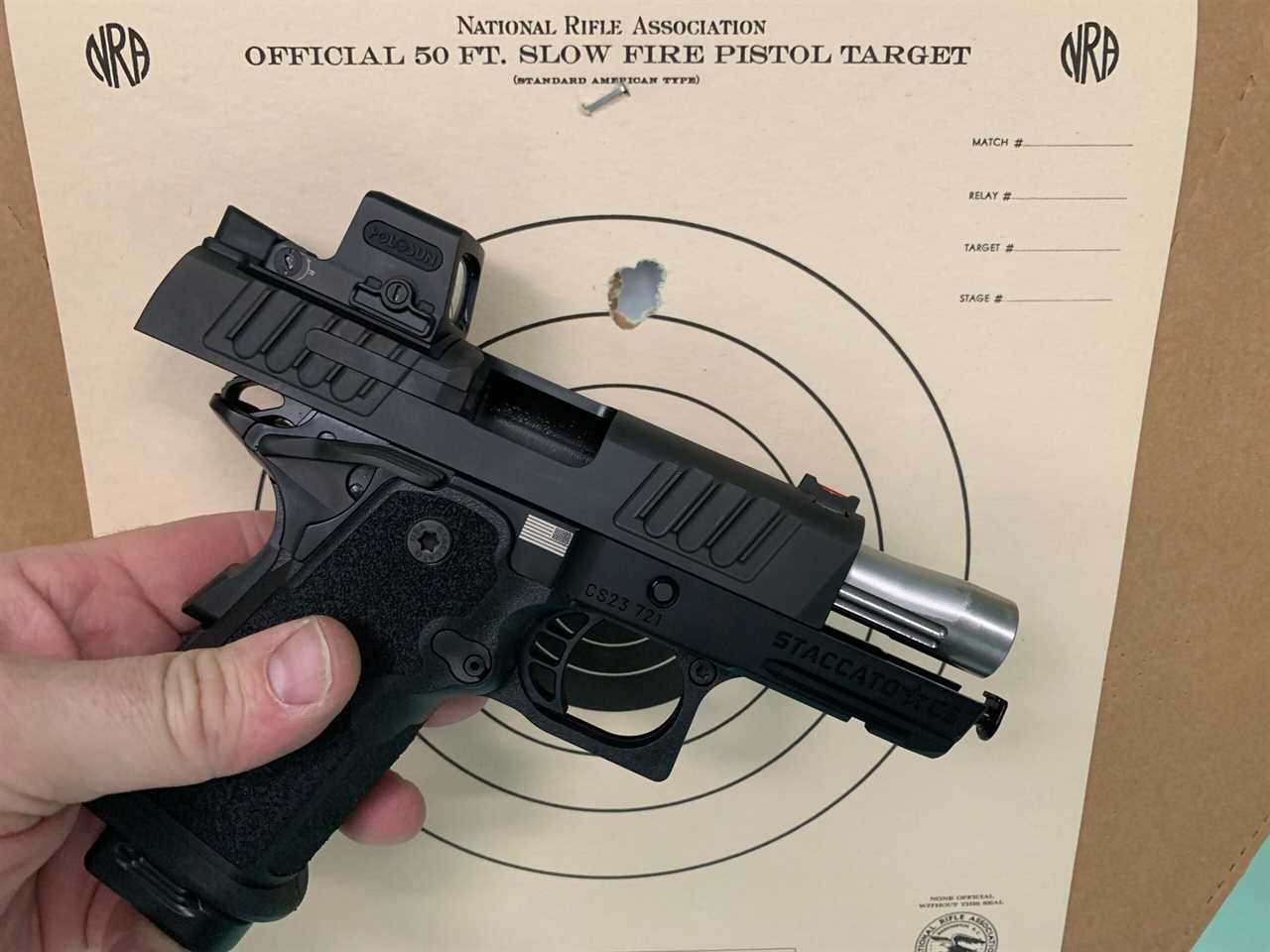
An excellent 5-shot group from 50 feet with the Staccato CS with Black HIlls 100-grain +P Honey Badger. Tyler Freel
Carrying the Staccato CS
The Staccato CS is designed and built to be a concealed-carry gun, but it might not be perfect for everyone. It firmly resides in the compact category, but is larger than the micro-compact 9mm pistols that have been hot-ticket items in recent years. It’s very similar in size to pistols like the G19, Sig P365 XMacro, Sig P320 XCompact, and Springfield XD-M Compact. It’s not a hard pistol to conceal, but your body type, dress style, climate, and method of carry will factor into how well it will work for you. I have carried the CS for over a month, and find that an IWB appendix carry is a good fit for me.
Holsters for the Staccato CS
Concealed-carry guns require holsters to use them properly, and there are already a few good options for the CS. I have been using a Blackpoint Tactical Dual Point IWB. The Shogun from LAS Concealment is another good option, and if you dig, you’ll find more. If you’re going to purchase a pistol like the CS, it’s worth trying a couple different models. You won’t be able to find them on the sporting goods store shelf, but you won’t find the CS there either.
Train With What You Carry
The Staccato CS is a Ferrari of concealed-carry guns but, if you’re like most folks who carry and shoot striker-fired guns, switching to a 1911-style pistol like the CS brings a couple caveats: train with what you carry, and don’t mix-and-match.
The facets of concealed carry are great, even fun, to discuss; but it’s also serious business. The biggest difference that striker-fired shooters will encounter when using a 1911-style pistol in a carry application is the safety. People who carry 1911-style pistols like the CS most commonly do so in condition one: chamber loaded, magazine loaded, hammer back, and safety on. On the range, getting used to disengaging the safety is easy, but it takes time to change your default actions when drawing under stress. Most striker-fired guns have no external safety, and if you’re not used to disengaging one, it can cost you precious time. Fortunately, the safety levers on the CS are easy to index your grip on and, with some practice, operating the safety quickly becomes an automatic part of the process.
In addition to acclimating to the manual safety, it’s important to avoid changing your carry setup regularly. Each handgun carries and points a little differently, and switching them up can cost you valuable time if you have to use it. For example, my carry gun for the past year has been a Sig P320 XCompact and, when switching over to the CS, it took some time and practice to become accustomed to the way the CS points. If I decide to carry the P320 tomorrow, I won’t be able to get on target as quickly because my default is now the CS.
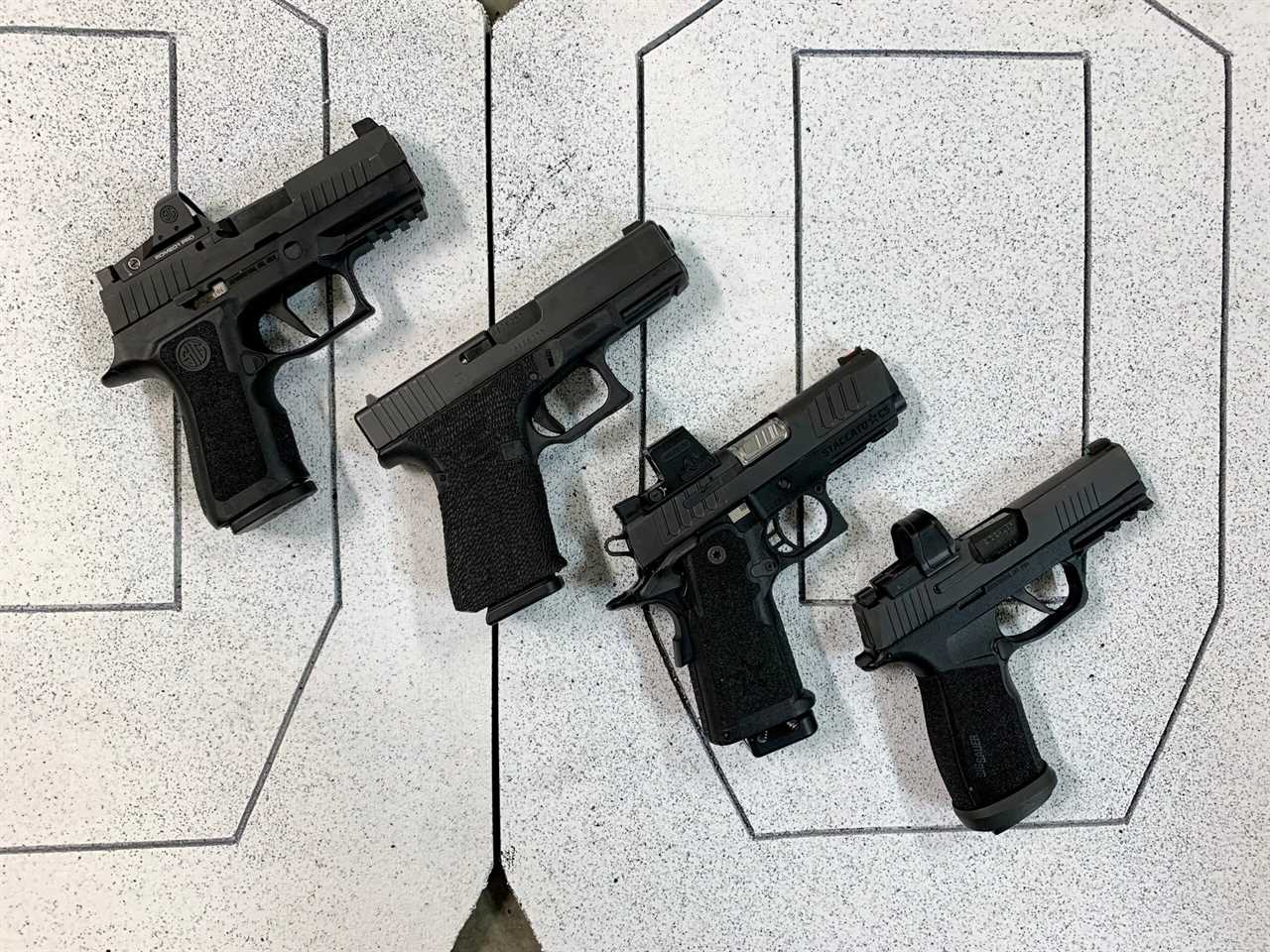
The Staccato CS is close in size to other compacts. From left to right: Sig P320 XCompact, Glock G19, Staccato CS, and the Sig P365 XMacro Tacops. Tyler Freel
What the Staccato CS Does Well
The Staccato CS gets top marks from me in just about every metric of performance. It’s reliable, compact, has great capacity, and most importantly—it’s really easy to shoot accurately.
Where the Staccato CS Could Be Better
The only thing that I think some shooters might not care for is also a factor with the larger Staccato pistols. The slide stop is tough to reach with the gun-hand thumb without breaking your grip. Many shooters use the support hand to break the slide stop loose, but if you’re not used to that, it will feel awkward.
Is the Staccato CS Worth the Money?
No matter the accolades or performance characteristics, the price of a gun is often a sticking point. Every shooter has to work within a budget, and value plays a huge role in what we pick. The Staccato CS is far from the most expensive 2011 on the market, but it does command a premium price. Is it worth it? That depends.
Objectively, the materials, workmanship, and performance are there. The Staccato CS stands apart from every lower-priced gun I could compare it to—even full-size pistols. If you’re a seasoned pistol shooter or shoot the CS alongside run-of-the-mill compact 9mm pistols, you’ll see the differences instantly. For a serious shooter, or someone who wants a best-in-class concealed-carry pistol, it’s worth every penny. In fact, I would personally find it worthwhile to forgo four or five of my other pistols if it meant I could afford the CS.
The other reality is that not every individual will see the value in the Staccato CS. There are some great, effective concealed-carry guns that are much cheaper, and although they objectively are not on the same level as the CS, they aren’t bad choices. Stick to your budget, and don’t go mortgaging the family farm to purchase a top-shelf pistol if it’s not a realistic buy for you. If you’re a beginner or don’t shoot much, the benefits of the CS won’t seem as pronounced as they do when you’re shooting constantly. Sure, you will likely be able to shoot it well, but a top-speed sports car isn’t what everyone wants or needs. Damn if you won’t want one after you get behind the wheel, though.
The post The Staccato CS: Tested and Reviewed appeared first on Outdoor Life.
Articles may contain affiliate links which enable us to share in the revenue of any purchases made.
By: Tyler Freel
Title: The Staccato CS: Tested and Reviewed
Sourced From: www.outdoorlife.com/guns/staccato-cs-review/
Published Date: Thu, 16 Mar 2023 16:00:00 +0000
----------------------------------------------
 Backyard GrillingWeekend WarriorsAdvice from DadBeard GroomingTV Shows for Guys4x4 Off-Road CarsMens FashionSports NewsAncient Archeology World NewsPrivacy PolicyTerms And Conditions
Backyard GrillingWeekend WarriorsAdvice from DadBeard GroomingTV Shows for Guys4x4 Off-Road CarsMens FashionSports NewsAncient Archeology World NewsPrivacy PolicyTerms And Conditions
